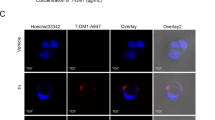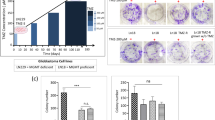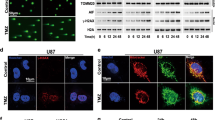Abstract
Autophagy is originally named as a process of protein recycling. It begins with sequestering cytoplasmic organelles in a membrane vacuole called autophagosome. Autophagosomes then fuse with lysosomes, where the materials inside are degraded and recycled. To date, however, little is known about the role of autophagy in cancer therapy. In this study, we present that temozolomide (TMZ), a new alkylating agent, inhibited the viability of malignant glioma cells in a dose-dependent manner and induced G2/M arrest. At a clinically achievable dose (100 μM), TMZ induced autophagy, but not apoptosis in malignant glioma cells. After the treatment with TMZ, microtubule-associated protein light-chain 3 (LC3), a mammalian homologue of Apg8p/Aut7p essential for amino-acid starvation-induced autophagy in yeast, was recruited on autophagosome membranes. When autophagy was prevented at an early stage by 3-methyladenine, a phosphatidylinositol 3-phosphate kinase inhibitor, not only the characteristic pattern of LC3 localization, but also the antitumor effect of TMZ was suppressed. On the other hand, bafilomycin A1, a specific inhibitor of vacuolar type H+-ATPase, that prevents autophagy at a late stage by inhibiting fusion between autophagosomes and lysosomes, sensitized tumor cells to TMZ by inducing apoptosis through activation of caspase-3 with mitochondrial and lysosomal membrane permeabilization, while LC3 localization pattern stayed the same. These results indicate that TMZ induces autophagy in malignant glioma cells. Application of an autophagy inhibitor that works after the association of LC3 with autophagosome membrane, such as bafilomycin A1, is expected to enhance the cytotoxicity of TMZ for malignant gliomas.
Similar content being viewed by others
Log in or create a free account to read this content
Gain free access to this article, as well as selected content from this journal and more on nature.com
or
Abbreviations
- TMZ:
-
temozolomide
- LC3:
-
microtubule-associated protein light-chain 3
- 3-MA:
-
3-methyladenine
- GBM:
-
glioblastoma multiforme
- AA:
-
anaplastic astrocytoma
- AVO:
-
acidic vesicular organelle
- PI3K:
-
phosphatidylinositol-3 kinase
- GFP:
-
green fluorescent protein
- DMSO:
-
dimethylsulfoxide
- Br-dUTP:
-
bromolated deoxyuridine triphosphate nucleotides
- FITC:
-
fluorescent isothiocyanate
References
Mahaley MS, Mettlin C, Matarajan N, Laws ER and Peace BB (1989) National survery of patterns of care for brain-tumor patients. J. Neurosurg. 71: 826–836
Avgeropoulos NG. and Batchelor TT (1994) New treatment strategies for malignant gliomas. Oncologist 4: 209–224
Bower M, Newlands ES, Bleehen NM, Brada M, Begent RJ, Calvert H, Colquhoun I, Lewis P and Brampton MH (1997) Multicentre CRC phase II trial of temozolomide in recurrent or progressive high-grade glioma. Cancer Chemother. Pharmacol. 40: 484–488
Yung WK, Prados MD, Yaya-Tur R, Rosenfeld SS, Brada M, Friedman HS, Albright R, Olson J, Chang SM, O'Neill AM, Friedman AH, Bruner J, Yue N, Dugan M, Zaknoen S and Levin VA (1999) Multicenter phase II trial of temozolomide in patients with anaplastic astrocytoma or anaplastic ligoastrocytoma at first relapse. Temodal Brain Tumor Group. J. Clin. Oncol. 17: 2762–2771
Stevens MF, Hickman JA, Stone R, Gibson NW, Baig GU, Lunt E and Newton CG (1984) Antitumor imidazotetrazines. 1. Synthesis and chemistry of 8-carbamoyl-3-(2-chloroethyl)imidazo-1,2,3,5-tetrazin-4(3H)-one, a novel broad-spectrum antitumor agent. J. Med. Chem. 27: 196–201
Newlands ES, Stevens MF, Wedge SR, Wheelhouse RT and Brock C (1997) Temozolomide: a review of its discovery, chemical properties, pre-clinical development and clinical trials. Cancer Treat. Rev. 23: 35–61
Agarwala SS and Kirkwood JM (2000) Temozolomide, a novel alkylating agent with activity in the central nervous system, may improve the treatment of advanced metastatic melanoma. Oncologist 5: 144–151
Friedman HS, Kerby T and Calvert H (2000) Temozolomide and treatment of malignant glioma. Clin. Cancer Res. 6: 2585–2597
Denny BJ, Wheelhouse RT, Stevens MF, Tsang LL and Slack JA (1994) NMR and molecular modeling investigation of the mechanism of activation of the antitumor drug temozolomide and its interaction with DNA. Biochemistry 33: 9045–9051
D'Atri S, Piccioni D, Castellano A, Tuorto V, Franchi A, Lu K, Christiansen N, Frankel S, Rustum YM and Papa G (1995) Chemosensitivity to triazene compounds and O6-alkylguanine-DNA alkyltransferase levels: studies with blasts of leukaemic patients. Ann. Oncol. 6: 389–393
D'Atri S, Tentori L, Lacal PM, Graziani G, Pagani E, Benincasa E, Zambruno G, Bonmassar E and Jiricny J (1998) Involvement of the mismatch repair system in temozolomide-induced apoptosis. Mol. Pharmacol. 54: 334–341
Hirose Y, Berger MS and Pieper RO (2001) p53 effects both the duration of G2/M arrest and the fate of temozolomide-treated human glioblastoma cells. Cancer Res. 61: 1957–1963
Kondo S, Barna BP, Morimura T, Takeuchi J, Yuan J, Akbasak A and Barnett GH (1995) Interleukin-1 β-converting enzyme mediates cisplatin-induced apoptosis in malignant glioma cells. Cancer Res. 55: 6166–6171
Bursch W, Ellinger A, Kienzl H, Torok L, Pandey S, Sikorska M, Walker R and Hermann RS (1996) Active cell death induced by the anti-estrogens tamoxifen and ICI 164 384 in human mammary carcinoma cells (MCF-7) in culture: the role of autophagy. Carcinogenesis 17: 1595–1607
Paglin S, Hollister T, Delohery T, Hackett N, McMahill M, Sphicas E, Domingo D and Yahalom J (2001) A novel response of cancer cells to radiation involves autophagy and formation of acidic vesicles. Cancer Res. 61: 439–444
Yao KC, Komata T, Kondo Y, Kanzawa T, Kondo S and Germano IM (2003) Molecular response of human glioblastoma multiforme cells to ionizing radiation: cell cycle arrest, modulation of the expression of cyclin-dependent kinase inhibitors, and autophagy. J. Neurosurg. 98: 378–384
Kanzawa T, Kondo Y, Ito H, Kondo S and Germano I (2003) Induction of autophagic cell death in malignant glioma cells by arsenic trioxide. Cancer Res. 63: 2103–2108
Kabeya Y, Mizushima N, Ueno T, Yamamoto A, Kirisako T, Noda T, Kominami E, Ohsumi Y and Yoshimori T (2000) LC3, a mammalian homologue of yeast Apg8p, is localized in autophagosome membranes after processing. EMBO J. 19: 5720–5728
Mizushima N, Yamamoto A, Hatano M, Kobayashi Y, Kabeya Y, Suzuki K, Tokuhisa T, Ohsumi Y and Yoshimori T (2001) Dissection of autophagosome formation using Apg5-deficient mouse embryonic stem cells. J. Cell Biol. 152: 657–668
Kim J and Klionsky DJ (2000) Autophagy, cytoplasm-to-vacuole targeting pathway, and pexophagy in yeast and mammalian cells. Annu. Rev. Biochem. 69: 303–342
Yamamoto A, Tagawa Y, Yoshimori T, Moriyama Y, Masaki R and Tashiro Y (1998) Bafilomycin A1 prevents maturation of autophagic vacuoles by inhibiting fusion between autophagosomes and lysosomes in rat hepatoma cell line, H-4-II-E cells. Cell Struct. Funct. 23: 33–42
Manabe T, Yoshimori T, Henomatsu N and Tashiro Y (1993) Inhibitors of vacuolar-type H (+)-ATPase suppresses proliferation of cultured cells. J. Cell. Physiol. 157: 445–452
Munafo DB and Colombo MI (2001) A novel assay to study autophagy: regulation of autophagosome vacuole size by amino acid deprivation. J. Cell Sci. 114: 3619–3629
Nara A, Mizushima N, Yamamoto A, Kabeya Y, Ohsumi Y and Yoshimori T (2002) SKD1 AAA ATPase-dependent endosomal transport is involved in autolysosome formation. Cell Struct. Funct. 27: 29–37
Boya P, Gonzalez-Polo RA, Poncet D, Andreau K, Vieira HL, Roumier T, Perfettini JL and Kroemer G (2003) Mitochondrial membrane permeabilization is a critical step of lysosome-initiated apoptosis induced by hydroxychloroquine. Oncogene 22: 3927–3936
Seglen PO and Bohley P (1992) Autophagy and other vacuolar protein degradation mechanisms. Experientia 48: 158–172
Blommaart EF, Krause U, Schellens JP, Vreeling-Sindelarova H and Meijer AJ (1997) The phosphatidylinositol 3-kinase inhibitors wortmannin and LY294002 inhibit autophagy in isolated rat hepatocytes. Eur. J. Biochem. 243: 240–246
Vanhaesebroeck B, Leevers SJ, Panayotou G and Waterfield MD (1997) Phosphoinositide 3-kinases: a conserved family of signal transducers. Trends Biochem. Sci. 22: 267–272
Toker A and Cantley LC (1997) Signalling through the lipid products of phosphoinositide-3-OH kinase. Nature 387: 673–676
De Camilli P, Emr SD, McPherson PS and Novick P (1996) Phosphoinositides as regulators in membrane traffic. Science 271: 1533–1539
Petiot A, Ogier-Denis E, Blommaart EF, Meijer AJ and Codogno P (2000) Distinct classes of phosphatidylinositol 3′-kinases are involved in signaling pathways that control macroautophagy in HT-29 cells. J. Biol. Chem. 275: 992–998
Klionsky DJ and Ohsumi Y (1999) Vacuolar import of proteins and organelles from the cytoplasm. Annu. Rev. Cell Dev. Biol. 15: 1–32
Liang XH, Jackson S, Seaman M, Brown K, Kempkes B, Hibshoosh H and Levine B (1999) Induction of autophagy and inhibition of tumorigenesis by beclin 1. Nature 402: 672–676
Arico S, Petiot A, Bauvy C, Dubbelhuis PF, Meijer AJ, Codogno P and Ogier-Denis E (2001) The tumor suppressor PTEN positively regulates macroautophagy by inhibiting the phosphatidylinositol 3-kinase/protein kinase B pathway. J. Biol. Chem. 276: 35243–35246
Ogier-Denis E and Codogno P (2003) Autophagy a barrier or an adaptive response to cancer. Biochim. Biophys. Acta 1603: 113–128
Altan N, Chen Y, Schindler M and Simon SM (1998) Defective acidification in human breast tumor cells and implications for chemotherapy. J. Exp. Med. 187: 1583–1598
Bursch W, Ellinger A, Gerner C, Frohwein U and Schulte-Hermann R (2000) Programmed cell death (PCD). Apoptosis, autophagic PCD, or others? Ann. NY Acad. Sci. 926: 1–12
Bursch W, Hochegger K, Torok L, Marian B, Ellinger A and Hermann RS (2000) Autophagic and apoptotic types of programmed cell death exhibit different fates of cytoskeletal filaments. J. Cell Sci. 113 (Part 7): 1189–1198
Komata T, Kondo Y, Koga S, Ko SC, Chung LW and Kondo S (2000) Combination therapy of malignant glioma cells with 2-5A-antisense telomerase RNA and recombinant adenovirus p53. Gene Therapy 7: 2071–2079
Komata T, Kondo Y, Kanzawa T, Hirohata S, Koga S, Sumiyoshi H, Srinivasula SM, Barna BP, Germano IM, Takakura M, Inoue M, Alnemri ES, Shay JW, Kyo S and Kondo S (2001) Treatment of malignant glioma cells with the transfer of constitutively active caspase-6 using the human telomerase catalytic subunit (human telomerase reverse transcriptase) gene promoter. Cancer Res. 61: 5796–5802
Bruick RK (2000) Expression of the gene encoding the proapoptotic Nip3 protein is induced by hypoxia. Proc. Natl. Acad. Sci. USA 97: 9082–9087
Koga S, Hirohata S, Kondo Y, Komata T, Takakura M, Inoue M, Kyo S and Kondo S (2000A) Novel telomerase-specific gene therapy: gene transfer of caspase-8 utilizing the human telomerase catalytic subunit gene promoter. Hum. Gene Ther. 11: 1397–1406
Acknowledgements
We thank Dr. T Yoshimori and Dr. N Mizushima for GFP-LC3 expression vector and the Schering–Plough Research Institute for TMZ. We also thank Dr. A Yamamoto and Dr. N Mizushima for helpful suggestions. This study was supported in part by the USPHS Grant 1R01 CA88936 (SK) awarded by the National Cancer Institute, in part by a start-up fund from The University of Texas MD Anderson Cancer Center, and in part by a generous donation from the Anthony D Bullock III Foundation.
Author information
Authors and Affiliations
Corresponding author
Additional information
Edited by Dr. CJ Thiele
Rights and permissions
About this article
Cite this article
Kanzawa, T., Germano, I., Komata, T. et al. Role of autophagy in temozolomide-induced cytotoxicity for malignant glioma cells. Cell Death Differ 11, 448–457 (2004). https://doi.org/10.1038/sj.cdd.4401359
Received:
Revised:
Accepted:
Published:
Issue date:
DOI: https://doi.org/10.1038/sj.cdd.4401359
Keywords
This article is cited by
-
Proapoptotic and proautophagy effect of H1-receptor antagonist desloratadine in human glioblastoma cell lines
Medical Oncology (2023)
-
Cytotoxic Activity of A New Isoform l-Amino Acid Oxidase (Balt-LAAO-II) From Bothrops alternatus (Urutu) Snake Venom in Human Leukemic HL60 Cells
International Journal of Peptide Research and Therapeutics (2023)
-
Temozolomide associated to gold nanoparticles promoted a synergic effect and apoptosis when exposed to melanoma cells
Journal of Nanoparticle Research (2022)
-
Two species of Ulva inhibits the progression of cervical cancer cells SiHa by means of autophagic cell death induction
3 Biotech (2021)
-
RETRACTED ARTICLE: Berberine reduces temozolomide resistance by inducing autophagy via the ERK1/2 signaling pathway in glioblastoma
Cancer Cell International (2020)



